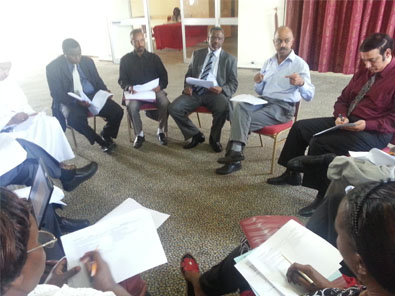The two-day high level policy workshop held in Rwanda’s Capital, Kigali, aimed at validating the Climate Change Resilience Status Reports for the Nile Basin Countries recommended to the momentum towards adopting climate change resilient practices as a means towards reducing water stresses in the Rive Nile Basin.
Participants were drawn from nine Nile Basin Countries, 8 Country Water Partnerships, Government Institutions, GWP Eastern Africa Partners: Nile Basin Initiative (NBI), research, academic and media institutions.
Nile Basin Countries and Climate Change
Though the 9 countries (Kenya, Rwanda, Burundi, Uganda, Tanzania, Ethiopia, Sudan, Egypt, Democratic Republic of Congo), have specific variations in cultures, policies and practices and institutional frameworks, climate change continues to be a across-cutting factor impacting their socio-economic livelihoods mainly agriculture, food security, hydro-energy production, water quantity and quality as well as mining safety and costs.
It was noted that increasing population growth and poor land use through unfriendly farming practices still stand out among the critical factors threatening climate and water security in earlier mentioned countries.
One common characteristic of these countries is unpredictable seasons; persistent droughts, torrential rains followed by destructive floods and continuous population exodus in search of water.
GWP Eastern Africa implements the Adapting to Climate Change Induced Water Stress in Nile River Basin Project with a consortium of other implementing partners: the Nile Basin Initiative, Danish Hydraulic Institute, United Nations Environmental Program (UNEP).
Officiating the workshop, the representative from Rwanda Natural Resources Ministry, Ms Lyliose Umupfasoni, Director for Environment, Water Resources and Forests, hailed the “existing regional cooperation in addressing shared challenges by managing trans-boundary water resources and adapting to the impacts of climate change.”
“Partnering with GWP Eastern Africa helps in addressing some of the gaps in adapting to climate change, policy making, decision making and to adjust existing policies,” Rwanda’s Ministry official added.
GWP Eastern Africa Regional Coordinator, Mr. Safari Patrick, pointed out the project objectives, expected outcomes, roles of different implementing partners and rationale of the Kigali’ 2nd High Level Policy Workshop to the participants.
“The workshop provides opportunity for discussing the outputs of the project achieved by various implementing partners since the project begun and consult on what actions to be followed at regional, national and local levels,” GWP Eastern Africa Regional Coordinator indicated.
Realized milestones
In line with GWP Eastern Africa’s role in the implementation of the project, a series of high-level workshops, and policy-influencing meetings have been conducted and carried out the country status reports on climate resilience in each River Nile Basin Countries whereas other activities (outputs) were still ongoing.
The project funded by SIDA and Coordinated by UNEP, sought to increase the technical capacity of regional and national centers of excellence and research centers to support the adaptation actions of countries and communities.
The workshop was characterized by presentation of the project’s outputs, achieved results, ongoing activities and forthcoming priorities. Presentations included: the Hydrological Modeling and regional Hot Spot Analysis under Climate Change Scenarios: Implications for the Nile Basin Region; Stock-Taking of Climate Change Adaptation: Experience of Pilot Study from Ethiopia and Uganda.
Hotspots area and fixing problems
Nile Delta Region (Egypt), Ethiopia highlands, Mount Elgon (Kenya) and Toska Depression were some of the identified hotspot areas of climate change areas needing focused attention.
“Floods and droughts can trigger or exacerbate the process of land degradation such as desertification, soil erosion and landslides thus affecting a big amount of land and water available for agriculture,” noted one presenter in the workshop.
Participants encourage to change unfriendly farming and other human driven practices that fuel negative nexuses between climate change and water stressors.
Interdisciplinary Expertise
Representing the Chair of GWP Eastern Africa, Prof Munguti Katua Kitua, from Kenya Water Partnership said that with diverse backgrounds of participants, their knowledge and expertise can lead to “incisive and enriched contribution towards the discourse on Adapting to Climate Change and Water Stress in the Nile River Basin Region.”
Project Goal and Work packages
The Project goal is to build resilience of ecosystem and economies that are most vulnerable to climate change induced water stress in the Nile Basin Countries.
Among other implementing partners, GWP Eastern Africa’s role in the implementation of the project is to provide institutional and policy support to countries in the Nile Basin Region. In terms of outputs, GWP Eastern Africa is responsible for:
- providing technical input to Integrated Water Resources Management (IWRM) options to basin-wide climate change adaptation planning and ensure linkages with national planning;
- conducting high-level regional policy roundtable to prioritize technical, financial and policy options for adaptation at basin levels;
- carrying out assessment of different IWRM options for resilience and their policy implications for the major sectors in Nile basin countries;
- conducting trainings, information management and dissemination through climate change adaptation portal and awareness materials.
Way forwardSince its inception in 2010, Adapting to Climate Change Induced Water Stress in Nile River Basin Project has had stimulated significant milestones in terms of achievements and several lessons have been learned. The workshop recommended that the next phase of the Project should be informed by and base on the achieved milestones and lessons learnt.
Other key recommendations drawn included: proper water management, reduced deforestation, change of farming techniques and to establish early warning systems.
Key facts:
- River Nile is generally regarded the longest river in the world with a drainage system exceeding 3 million square km;
- River Nile is shared by 11 countries: Burundi, DR Congo, Egypt, Eritrea, Ethiopia, Kenya, Rwanda, Southern Sudan, Sudan, Tanzania & Uganda;
- River Nile’s flow starts south and moves northwards through Sahara Desert where precipitation is less 100mm—meaning the river is the lifeblood of the region;
- River Nile has many tributaries, the main ones: the White Nile and Brue Nile;
- River Nile has diverse ecosystems ranging from forests, moorlands, humid lowlands, savannah grasslands, aquatic, plant and animal species(source: The State of the Nile Basin Report 2012)
